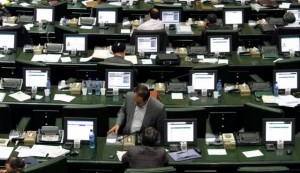 Iran�s parliament approved a plan to issue food stamps [Feb. 24] every third month to beneficiaries of the Imam Khomeini's Relief Foundation and the Welfare Organization, more commonly known as�Iran�s poor.
Iran�s parliament approved a plan to issue food stamps [Feb. 24] every third month to beneficiaries of the Imam Khomeini's Relief Foundation and the Welfare Organization, more commonly known as�Iran�s poor.The stamps for staples of rice, sugar, oil and meat are designed to support the value of existing welfare payments, which have been eroded by high Inflation in the Islamic Republic. They are the brainchild of Ahmad Tavakoli, a member of parliament and a prominent government critic who has a doctorate in economics from Britain�s Nottingham University. According to Tavakoli, the stamps will be issued to the 7 million poorest Iranians and have been made necessary due to the high inflation caused by Iran�s currency crisis and the Ahmadinejad administration�s poor fiscal control.
Although the bill though passed with a big majority, it has been criticized by loyalists of�President Mahmoud Ahmadinejad�and his IMF-supported subsidy reform plan, which is designed to admit Iran into the World Trade Organization by stripping price supports on fuel and food.
Ahmedinejad�s allies are trying to scupper the plan. Critics have said that the proposal undoes the work achieved by the subsidy reforms and will �send Iran back to the past,� implying the dark days of the Iran-Iraq War when coupons were the norm. Seyyed Ebrahim Ebrahimi, a member of the presidential office parliamentary directorate, said the plan is pointless because the government already saves 20% of oil revenues in its national development fund, which is in part used to support the poor.
Defending the bill, Tavakoli said stamps are a sensible idea and, unlike during the war, would only be used by the poor rather than every citizen. He rejected the Persian adage �couponism is communism� applied to his plan, a rhyme in Farsi that was leveled by conservatives against the nascent reformists during the war years. Tavakoli even compared his proposal to the U.S. food coupon plan used by 47.5 million Americans.
Few officials in Iran doubt the need for subsidy�reform, with arguments usually limited to how to execute it. Before reforms started in late 2010, Iran spent an estimated $70 billion, twice the government budget, on energy subsidies, which preferentially benefited the rich who consumed more. After a presidential term spent handing out Iran�s oil rents as gifts to the poor � or, as he called it, �putting Iran�s oil money onto dinner tables� � prices skyrocketed and Ahmadinejad was forced to change track.
He slashed subsidies and redistributed half of the money saved to the bank accounts of the poor. The move was both populist and "market-friendly" and unlike many of his other economic decisions, achieved some level of success. It achieved huge price adjustments in prices without major public backlash; reduced domestic consumption and waste; and dampened the huge black market in neighboring countries for cheap Iranian petrol. According to a paper by Djavad Salehi-Isfahani, a Virginia Tech economics professor, subsidy reform even reduced poverty in Iran.
But with June�s elections approaching, the food stamp is being used by the principlists as a club to beat the president with. The principilists, who claim fidelity to Khomeini�s revolutionary principles and represent the biggest power bloc in Iran today, are courting the poorer voters who constitute Ahmadinejad�s core constituency to win votes and try and cast the president as an enemy of the good. Most of them detest the president for challenging the authority of Supreme Leader Ali Khamenei. Although the principilists will likely monopolize the Guardian Council approved candidate list for the June 14 election, by outflanking the president at his own game they seek to stymie his widely tipped aspirations to groom a successor for the election.
By Al-Monitor
The Iran Project is not responsible for the content of quoted articles.










